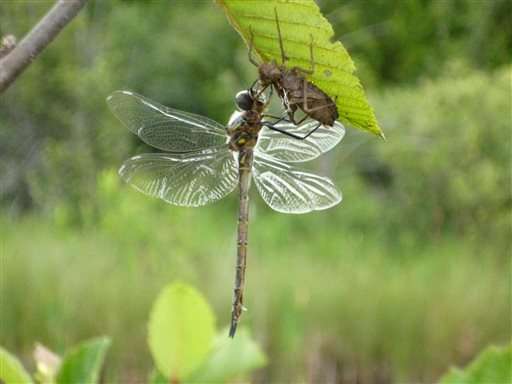Endangered dragonflies, raised in captivity, being released

Federally endangered dragonflies that have been raised in a laboratory over the past several years are being released at a forest preserve this week in Illinois, where scientists believe they'll be a good match with the small population still there.
The Hine's emerald dragonflies, which for decades were believed to be extinct, were carefully raised at the University of South Dakota over the past four to five years after eggs were collected from a dragonfly in southwestern Wisconsin. Three out of the 20 dragonflies that could be released have already been freed so far this week at a forest preserve near Chicago. No more than 320 of the insects remain in Illinois.
"We are trying to maximize their survivorship in captivity," said Daniel Soluk, a professor at the University of South Dakota and the project leader. In the wild, he said, not very many dragonfly eggs survive to become adults—perhaps 10 of 1,000. Bringing them into the lab can dramatically increase their chances, so that of the same group maybe 100 or even 200 survive "all the way to where they'd be ready to emerge into adulthood."
The Hine's emerald dragonfly was discovered in Ohio, but by the mid-1900s, scientists believed the insect was extinct. That changed when one adult specimen was collected in the Des Plaines River Valley, southwest of Chicago, in 1988 that was identified as this species. The Hine's emerald was listed as a federally endangered species in 1995, and it can now be found in Illinois, Michigan, Missouri and Wisconsin.
Female dragonflies lay eggs by dropping the tip of their body into shallow water. Immature dragonflies—known as nymphs—typically hatch from the eggs in the spring. Nymphs live in the water for about four years, until they crawl out, shed their skin one last time and emerge as flying adults. The adults live only four to five weeks between June and August.
The eggs for this project were collected from a dragonfly captured in southwestern Wisconsin, Soluk said, because the Hine's emerald dragonflies in that area have the same diverse genetic composition as the ones found in Illinois.
"You may have lots of numbers, but if they're genetically almost identical, that means there's not as much ability to resist something like a disease that comes along or that they just won't have as much flexibility in terms of quick responses to things like change in conditions," Soluk said.
Between 80 and 320 Hine's emerald larvae emerge as flying adults in Illinois every year, said Kristopher Lah, an endangered species coordinator at the U.S. Fish and Wildlife Service's Chicago Ecological Services Field Office.
For years the environmental group Nature Conservancy has worked to preserve the species in Door County, Wisconsin, where coastal springs and wetlands create a rich habitat for the dragonflies, which catch and eat small flying insects, including mosquitoes, gnats and biting flies.
The effort, says the group's ecologist Mike Grimm, goes beyond the dragonfly's role in nature.
"We never hardly ask 'Why is the Mona Lisa important?' We could tear it down, burn it, and would civilization collapse? No," Grimm said. "But it's something that we value because it's beautiful or it has some intrinsic value that we just want to protect. Some species, what is their value? A small butterfly doesn't really have any economic value and probably could go extinct and we'd never even know it. But I think there's an obligation to our future generations of people that we try to preserve the Earth in at least as good a condition as we found it."
© 2015 The Associated Press. All rights reserved.




















